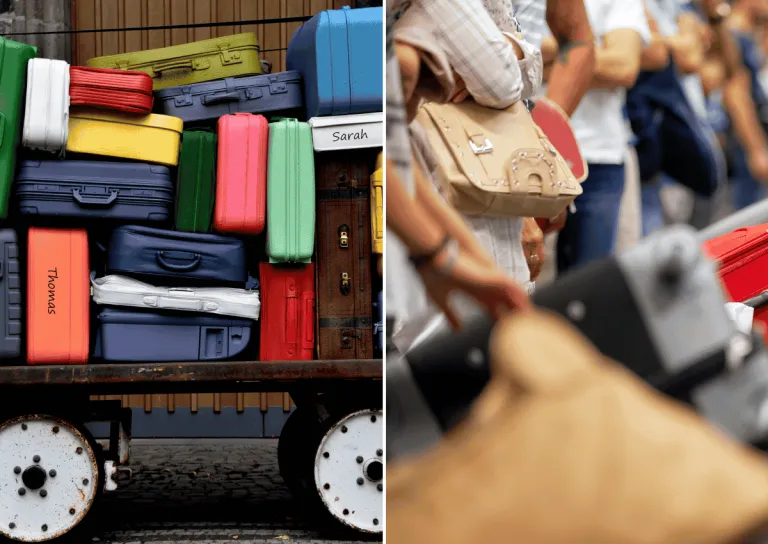Our favourite places to stay on this sleepy Cebu island.
Japan's Hands-Free Travel? How Overtourism is Impacting Japan's Public Transit

As Japan welcomes an influx of tourists, the country is grappling with a growing concern: the clutter caused by large suitcases in public transit systems. With over three million visitors each month, cities like Kyoto and Tokyo are feeling the pinch, leading locals to voice their frustrations over the inconvenience caused by oversized luggage. A solution that they could think of is Japan’s hands-free travel system.
Also read: Tourism Boom Prompts Japan to Consider Dual Pricing System
What it means for Japan’s hands-free travel system

The surge in tourism has resulted in overcrowded public transport, with residents sharing their grievances on social media. One viral image from Kyoto depicted buses so packed with suitcases that passengers could hardly navigate the aisles. In another post, a traveller was reprimanded for blocking a space reserved for passengers, responding dismissively, "Who cares? I don’t care." Such incidents have sparked calls for tourists to adopt "hands-free travel" practices.
The situation has escalated to the point where local authorities are taking action. In Kyoto, dedicated buses for tourists have been introduced to alleviate pressure on the regular transit system. However, the growing number of large suitcases poses an additional challenge on trains and at stations. As tourists rush to catch their trains during peak hours, the resulting congestion hampers the movement of commuters, especially those with disabilities or parents with strollers.
In response to this ongoing issue, the Japan National Travel Organization (JNTO) has launched a campaign aimed at promoting lighter travel. Their "Hands-Free Travel" initiative encourages visitors to consider various luggage transfer services available throughout Japan. This includes options for shipping luggage directly from airports to hotels, minimising the need for large bags on public transport.
Additionally, new services are being tested, such as Tokyo’s pikuraku Porter, which allows travellers to deposit their luggage at train stations and arrange for delivery to nearby hotels. Meanwhile, Kyoto is sponsoring a “hands-free tourist bus” dedicated to transporting oversized luggage, providing a much-needed solution for travellers.
However, the issues caused by over tourism extend beyond just luggage. Locals have reported encounters with rude tourists, language barriers in service interactions, and even instances of trespassing in culturally sensitive areas like Kyoto's Gion geisha district.
Also read: Japan’s Tourism Boom Causes Strain on Credit Card Companies
Despite these challenges, Japan aims to boost its tourism numbers from 35 million to 60 million by 2030. Achieving this ambitious goal will require not only enhancing infrastructure but also fostering a culture of respect and awareness among travellers. As the nation continues to navigate these growing pains, the call for more sustainable tourism practices has never been more urgent.
Featured image credit: Mikhail Nilov via Canva Pro
Published at
About Author
Anne Mercado
Subscribe our Newsletter
Get our weekly tips and travel news!
Recommended Articles
10 Bantayan Island Resorts, Hotels, and Rentals for Your Tropical Escape 10 Best Mountain Cafes in the Philippines for Your Peak Coffee Experience Coffee date on the mountains, anyone?
10 Best Things to Do in Los Angeles Los Angeles is more than Hollywood stars. From hikes with killer views to beaches straight out of a rom-com, here are 10 must-do LA experiences for Filipino travellers or any wanderers in general!
10 Cutest Cafes in Japan That Are Totally One of a Kind From Pikachu snacks to Totoro cream puffs, here are 10 themed cafes in Japan that prove café hopping should be part of your travel itinerary.
10-day Christmas and New Year Japan Trip: Complete Travel Itinerary Celebrate Christmas and New Year in Japan with this 10-day holiday vacation itinerary packed with Tokyo lights, Kyoto charm, and Osaka adventures.
Latest Articles
Free Airport Shuttle by Grab: How to Ride from NAIA Terminal 3 to One Ayala This December Free airport ride home this holiday season!!!
From Night Markets to Michelin Stars: Filipino Foodies Reveal Their Favourite Taiwanese Food! Filipinos love Taiwanese food more than they realise!
Understanding Passport Cancellation in the Philippines A quick guide on why the DFA cancels passports and the legal grounds behind it.
US to End Dual Citizenship? Here’s What Filipinos Should Know If this bill passes, Filipino dual citizens must choose between U.S. and Philippine citizenship within one year or risk losing U.S. nationality.
Shibuya Cancels New Year’s Eve Countdown Again: What Filipino Travellers Need to Know Shibuya has cancelled its New Year’s Eve countdown for 2025/2026. Filipino travellers planning a Tokyo trip should know about street closures, alcohol bans, and safe festive alternatives.

